Range Rover Service Schedule: Maintenance
Here’s a straightforward breakdown of what you need to know about your Range Rover service schedule. Owning a Range Rover is about more than just driving a car – it’s about the experience. To keep your vehicle performing at its best, regular maintenance is key. With the right care, your Range Rover will be a reliable companion for years to come.
How Often Should You Service Your Range Rover?
Range Rovers have clear service intervals that help you know when it’s time for a checkup. Whether you’re racking up the miles or just cruising around town, it’s important to stick to the schedule.
Here’s a quick look at the service intervals for different models:
- Freelander: Every 12,000 miles or 12 months.
- Defender Td5: Every 12,000 miles or 12 months.
- Discovery 3/LR3, Range Rover Sport: Every 15,000 miles or 12 months.
- Range Rover: Every 15,000 miles or 12 months.
- Range Rover Armoured: Every 6,000 miles or 6 months.
For vehicles used in tough conditions (think lots of off-roading or extreme weather), you might need to adjust that schedule to every 7,500 miles or 12,000 km. Always better to be safe than sorry!
The Key Maintenance Jobs You Shouldn’t Skip
1. Engine Coolant Replacement
This keeps your engine from overheating. Here’s when to get it replaced:
- Defender: Every 36,000 miles or 3 years.
- Freelander: Every 38,000 miles or 3 years.
- Discovery/LR3: Every 10 years.
- Range Rover Sport & Range Rover: Every 10 years.
2. Brake Fluid Replacement
Good brakes are a no-brainer for safety, so brake fluid needs regular attention:
- Defender: Every 24,000 miles or 2 years.
- Freelander: Every 36,000 miles or 3 years.
- Discovery/LR3, Range Rover Sport, Range Rover: Every 3 years.
Does Your Range Rover Face Tough Conditions?
If you’re taking your Range Rover off-road, through muddy tracks, or driving in extreme temperatures, you might need to service your car more frequently. Some examples of arduous conditions include:
- Off-roading or rough terrain.
- Driving in very hot climates.
- Frequent towing.
- Driving in sandy or dusty environments.
In these cases, daily checks of key parts like lights, brakes, and fluid levels are a good idea. You’ll thank yourself later.
Keep an Eye on the Oil Service Indicator
Your Range Rover is smart – it will tell you when it needs an oil change with the Oil Service Indicator on the dashboard. Don’t ignore it! Regular oil changes keep your engine running smoothly and prevent wear over time.
DIY: What You Can Check at Home
It’s not all about the big services – taking care of the small things can save you hassle down the line. Here are a few checks you can easily do at home:
Daily Checks
- Make sure the lights, horn, and wipers are working.
- Check seat belts and brakes.
- Look for any fluid leaks under the car.
Weekly Checks (or Every 250 miles/400 km)
- Check the engine oil level.
- Look at the brake and coolant levels.
- Inspect tyre pressure and condition.
These small checks will keep your Range Rover running like a dream between services.
Where to Get Your Range Rover Serviced
For major services, it’s best to go to an authorized Land Rover Dealer or Repairer. They’ll know exactly what your car needs and can use the right fluids and parts. Plus, sticking to the authorized service centres helps keep your warranty intact.
Wrapping Up: Take Care of Your Range Rover, and It Will Take Care of You
Regular Range Rover Service Schedule maintenance is the secret to getting the most out of your Range Rover. Stick to the service intervals, do your at-home checks, and trust the pros for the big jobs. Whether you’re cruising through the city or tackling rough terrain, a well-maintained Range Rover is always up for the challenge. Keep it serviced, and enjoy every mile!
Buying a used VW. Buying used vauxhall, BMW, Jaguar, Ford, Volvo, Range rover, Bentley, Aston Martin, Porsche, Ferrari, Lamborghini, Maserati, Hyundai, Tesla, Honda, Pagani

